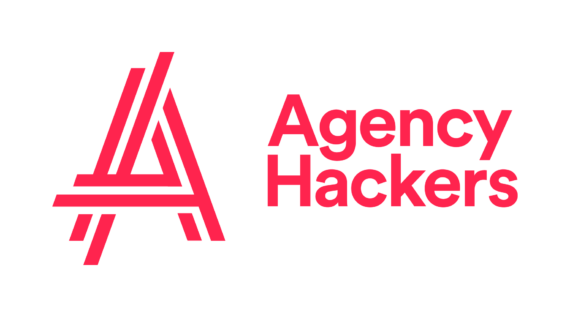Coming up At Agency Hackers
📣 Please note, these events are for Agency Hackers’ members only.
If your agency isn’t a member yet, get in touch with Anne or sign up here.
Event key:
🔵 Presentation
🔴 Interview
🟣 Demo/workshop
ALL our sessions are interactive, so cameras on and get your questions ready to ask!

- Big clients are exciting, but what happens to the smaller ones that still keep your studio ticking? At Huddle Creative, Nicole Posner is working on how to balance both.
- “We’re still taking on £15k–£20k projects, but only if there’s a clear reason – like future opportunities to grow the account – or if it’s creatively exciting,” she says. “And we’ve become much more granular in how we scope them.”
- It’s a shift that’s working. But while Huddle is now catching more of these white whales on a regular basis, they haven’t walked away from the smaller stuff. In fact, they’ve had to get laser-focused on managing that balance. If you’re scaling up and struggling to manage the mix, this session will show you how to make both ends of the spectrum work.

- Scams are everywhere, and they’re getting harder to spot. From phishing emails to fake invoices, it’s easy to fall for a scam if you’re not paying attention. Ralph Harrison, sales and marketing director at Cubit Technology – and Agency Hackers’ Recommended Partner for all things IT – wants to show the industry how to spot the warning signs before it’s too late.
- “Trust is good, but not from an IT perspective,” he warns. “If a house gets burgled, the first thing the owner does is install better locks and alarms. Don’t wait to be hacked, prevent it. Make your business a harder target and they’ll focus on the easier ones.”
- In this session, Ralph will take you through practical tips and show you how to turn every member of your team into a ‘human firewall’ against scams.
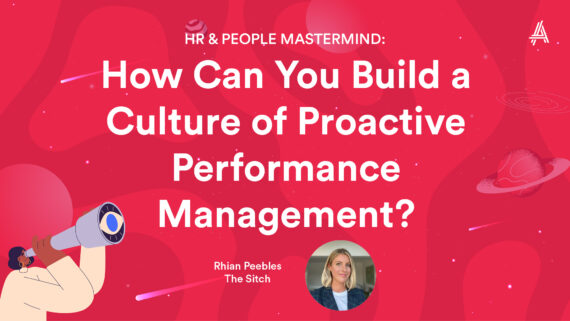
- “Nine times out of ten, when an agency leader brings me in for a complex issue, they’re at their wits’ end. Yet once we unpack it, I find nobody’s ever taken meaningful action.” This is what Rhian Peebles, founder of HR consultancy, The Sitch, faces on a regular basis.
- “It isn’t about being reactive,” Rhian explains. “It’s about creating regular habits that make performance conversations normal and part and parcel of the job – not just something you do when someone’s in trouble.”
- Rhian has developed a framework for proactive people management, built around their practical rituals and smart accountability. If you’re looking at ways to make your performance management more proactive within your agency, look no further.
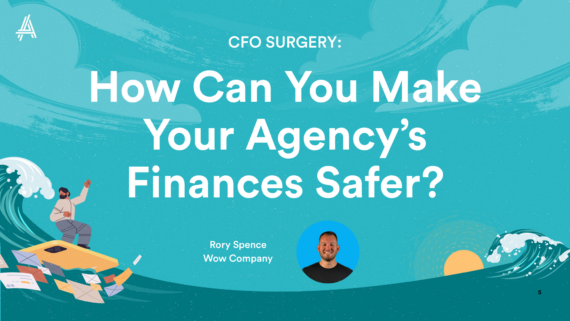
- Late payments are nothing new – but the real issue? Most agencies set themselves up to fail from the start. Whether it’s risky payment terms, over-reliance on project completion, or failing to build a cash buffer, Rory Spence has seen too many agencies flirting with financial chaos.
- “We’ve seen agencies agree to 50% on completion – and then act surprised when they don’t get paid,” says Rory, head of commercial at The Wow Company. “More than one in ten agencies only have a month’s overheads in the bank. That’s incredibly high risk.”
- In this session, Rory will lift the lid on how the smartest agencies are managing their money – and how to put payment structures, pricing models, and planning processes in place before cash flow becomes a crisis.

- It’s one thing to keep your clients happy. It’s another to grow those relationships and drive more revenue from the work you’re already doing. For many agencies, account growth is left to chance.
- But for Helen Knight, founder of Creative Business Brain, it’s all about growing your confidence, habits, and thinking in order to create intentional, consistent account growth. “Most people just aren’t shown how to do the growth side of things,” Helen explains. “And it’s really normal, so people shouldn’t feel bad about it.
- She believes sales doesn’t need to feel forced or unnatural – in fact, the best account growth “isn’t about selling at all”. As Helen says, “It’s actually all about listening.” doesn’t even feel like selling. In this session, Helen will guide us through the practical mindset shifts and behaviours that help creative teams stop waiting for growth and start creating it – one conversation at a time.
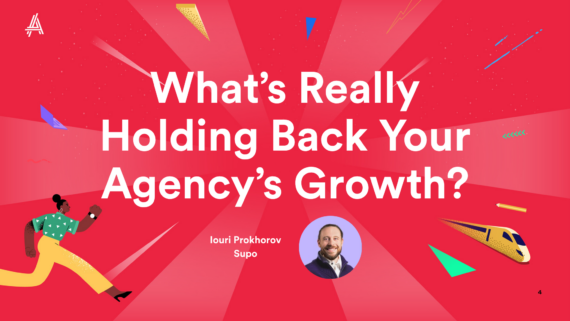
- “New business doesn’t fix everything.” For years, that was the golden rule. Win more work, and the rest will take care of itself. But that rulebook no longer works.
- “Most agencies are leaking from the other side,” says Iouri Prokhorov, founder of Supo, an Agency Hackers Recommended Partner. “You win work, but your profitability isn’t there. And if you’re not changing how your business operates, no amount of new revenue will save you.”
- In this session, Iouri will unpack the hard truths, and smarter playbooks, behind high-performing agencies. Based on two decades of building agencies and his work with Supo – a platform helping dozens of firms unlock operational intelligence – he’ll reveal the mindsets and models that lead to lasting success.
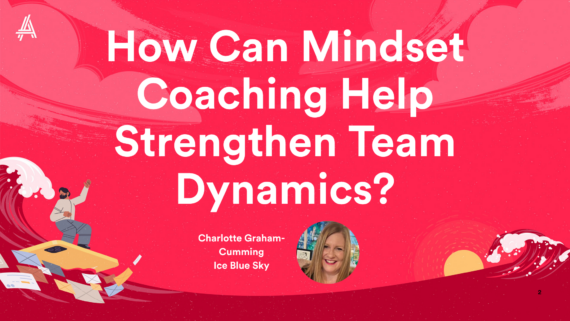
- In 2019, Charlotte Graham-Cumming found herself staring down the possible collapse of her agency, Ice Blue Sky. The business was under pressure, growth felt out of reach, and the stress was impacting how she led the business.
- “I realised I had to change the way I was thinking,” says Charlotte. “Because everything else felt out of my control.”
- That shift in thinking became the foundation for how she rebuilt her company – and how she leads the business today. In this session, Charlotte walks us through the mindset tools that helped her scale Ice Blue Sky, the coaching practices that brought her team closer together, and the simple daily habits she still uses to stay calm and focused under pressure.
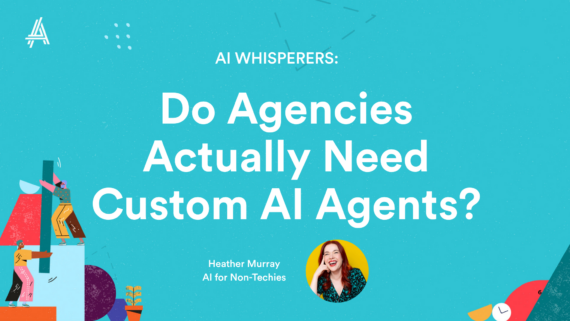
- When Heather Murray first explored AI agents, she hit a wall. This wasn’t because she couldn’t build one, but because she realised she simply didn’t want to. “I’m non-technical. I do not want to learn how to build agents. I’ve tried, and it’s way too hard. I’ve got no interest in JavaScript or APIs,” says Heather, founder of AI for Non-Techies (the clue is in the name).
- And crucially, she didn’t need to. While there’s a whole world out there full of custom GPTs, Zapier integrations, and stitched-together workflows, Heather argues that sometimes, simple is better.
- In this session, Heather will show you how she’s working with AI agents in a way that’s fast, accessible, and effective – no coding, no dev tools, no drama.
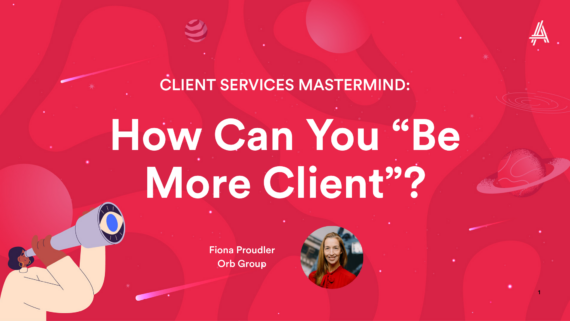
- In a saturated agency market, with declining spend and diminishing returns, it’s easy to fill LinkedIn with the kind of content you think clients want to consume – instead of tuning into what they actually want and need. Fiona Proudler, managing director of Orb Group, is here to deliver a wake-up call: none of it matters unless you’ve earned the right to sit at your client’s table.
- “Too many agencies pay lip service to understanding their clients, and take them for granted,” she says. “If you don’t fully invest in them as an individual, their brand and their business, you don’t deserve their work. It’s that simple.”
- This session will challenge you to get back to basics of the agency world, and how to put the client first in everything you do. Come ready to question your assumptions, sharpen your approach, and rediscover what it truly means to serve.

- In the rush to grow fast, win big, and shout the loudest, most agencies forget one crucial thing: if nobody wants to buy what you’re selling – now or in the future – what’s the point?
- That’s where Anna Stone comes in. With over 20 years navigating the commercial guts of agencies from founder-led startups to global players like Ogilvy, and now head of growth at True, she’s here to reframe the conversation around growth. Less about vanity metrics. More about value.
- In this online session, Anna will help you get clear on what really drives agency buyability. This is a no-BS guide to sharpening your story, targeting the right people, and finally answering the question: “Why would anyone choose you?”
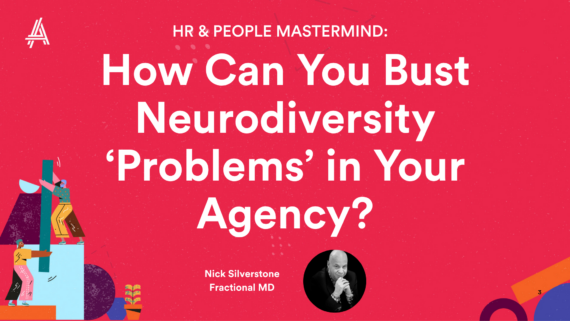
- Neurodiversity in agencies isn’t a niche concern anymore; it’s a widespread reality. And yet, many agencies still treat it as a challenge to manage, rather than an opportunity to embrace. “I thought my agency was disproportionate,” says Nick Silverstone, the Fractional MD. “But then I started talking to other people and thought, ‘Crikey, this is across the board.’”
- Having led a team where neurodiversity is common – and then realised it’s actually the industry norm – Nick has been building a panel of trainers, coaches, and HR professionals to help others do better.
- This session will unpack the misconceptions, mislabels, and missed opportunities that surround neurodiversity in creative work.

- Winning creative work in Saudi Arabia isn’t about booking the six-and-a-half hour flight and hoping for the best. It’s about understanding a region that’s rewriting the rules, and showing up with a message that lands.
- Pete Fergusson has been there. One of his agencies was appointed the creative agency for the bid for the 2034 World Cup. Now, he’s launching the Saudi Agency Network — a way for agencies to access serious opportunities in Saudi without burning through £100k just to open an office. But what are the main differences between agency work in the UK, compared to work in Saudi Arabia?
- In this session, Pete will share what it really takes to win work in Saudi. He’ll cover cultural expectations, regional rivalries, and how to stand out in a place that’s investing fast and thinking big.

- A strong pipeline can be just as dangerous as a weak one. It’s something Steve Parks, CEO of Convivio, is seeing play out in real time: “Agencies are finally seeing momentum – but they’re in headless chicken mode. Years of crisis have left them without the structure to handle demand, so founders are scrambling instead of leading.”
- Instead of enjoying the rewards of growth, many leaders are stuck firefighting – they’re being pulled into the weeds and unable to step back. This can leave them feeling overwhelmed with no time to think, no space to lead and no clear structure for growth.
- In this session Steve will explore how to structure your agency for stability, take advantage of global trends, and stop running your business in panic mode. A must-attend for any founder who wants to finish 2025 strong.

- There’s a big difference between delivering a pitch and actually connecting with your target audience. This interactive session with Alex Wright, Maddy Allen and Max “Hoppy” Hopkinson is designed to help you bring public speaking tools into your pitching process – so your ideas don’t just land, they resonate.
- Alex, Maddy and Max are all speaker coaches, presenters, and board members of The Keynote Club, a community and course platform that helps people become better speakers. “Public speaking is so critical to pitching,” says Alex, “and so it’s critical to the personal professional development journey of the people in agencies, too.”
- In this high-energy, interactive workshop, Alex, Maddy and Max will take you through real exercises, not just advice. They will be sharing breathing drills, and confidence-boosting techniques you can start using right away to improve your pitching.
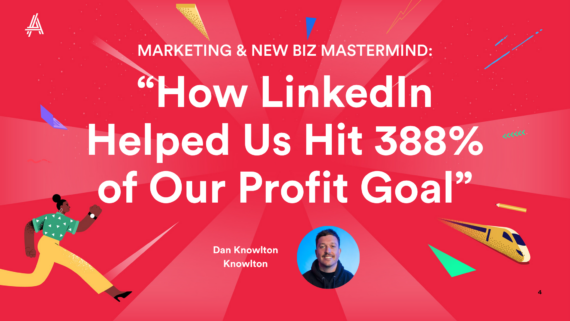
- What happens when you stop treating LinkedIn like a tick-box task, and start using it as a serious growth channel?
- “We literally had the best Q1 we’ve ever had this year,” says Dan Knowlton, co-founder of creative agency Knowlton. “We hit 388% of our profit goals – and most of our business came, and still comes, through LinkedIn.”
- In this online session, Dan will pull back the curtain on how his team transformed their approach to LinkedIn – turning it from a spammy, low-impact channel into a high-performing client magnet.

- “If something lands, we haven’t got a clue who’s gonna work on it.”
- Sound familiar? You’re not the only one staring down the barrel of over-capacity and second-guessing when to make your next hire. So, when is the right time to hire – and how do you do it without risking your bottom line?
- Sarah White, co-founder of Smile Digital Talent, sees this dilemma all the time, and in this session, she’ll be on hand to help you find a better understanding of when, and how, you should make that next hire.
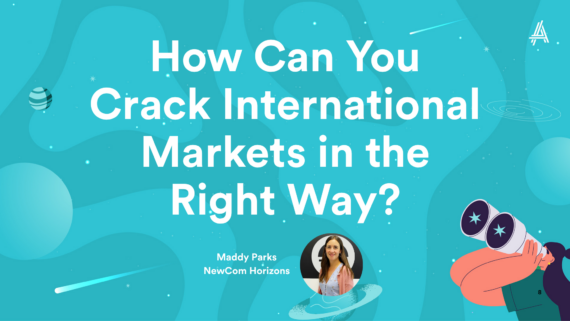
- More agencies are being pulled into international work, whether it’s a client eyeing expansion or a pitch that spans multiple markets. But once you’re beyond the UK, things get trickier fast: Who can you trust locally? How do you buy media or get reliable insight? How should you manage the brief without blowing the margin?
- It’s the kind of challenge Maddy Park deals with every day. As MD of NewCom Horizons, a Madrid-based agency that partners with independents across the world, Maddy helps UK agencies deliver when the brief goes beyond home turf.
- In this session, we’ll explore what it actually takes to operate internationally as an independent agency. From picking partners to managing margin, you’ll get a real-world look at the opportunities (and headaches) of going global.

